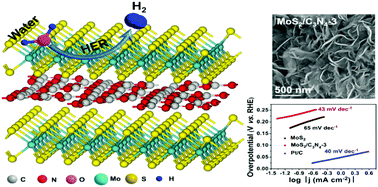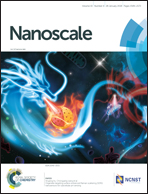Ultrathin molybdenum disulfide/carbon nitride nanosheets with abundant active sites for enhanced hydrogen evolution†
Abstract
The exploration of highly active catalysts for hydrogen evolution reaction (HER) is beneficial to realize high catalytic activity and enhance kinetics for water splitting. Herein, flower-like molybdenum disulfide/carbon nitride (MoS2/C3N4) nanosheets with thickness of 4.6 nm and enlarged interlayer spacing of 0.64 nm were synthesized via a facile hydrothermal method. As expected, the ultrathin thickness endowed MoS2/C3N4 with abundant active sites, ensuring outstanding catalytic activity and excellent stability for HER in alkaline electrolyte. MoS2/C3N4 nanocomposites can offer an onset overpotential of 153 mV versus reversible hydrogen electrode (RHE). Notably, the Tafel slope value is only 43 mV dec−1, which is significantly better than those of reported MoS2-based hydrogen evolution catalysts, revealing superior HER performance of MoS2/C3N4, particularly in catalytic kinetics. More significantly, density functional theory (DFT) calculations further verify that rich active sites confined in ultrathin nanostructure of g-C3N4 nanolayers could increase the activity of MoS2/C3N4 and result in enhanced HER efficiency. This study indicates that rational interaction between two different 2D materials can significantly facilitate H2 generation, which endows extraordinary HER activity.



 Please wait while we load your content...
Please wait while we load your content...